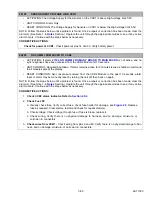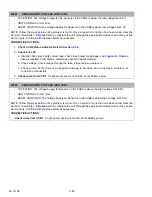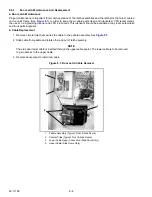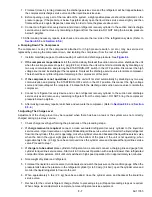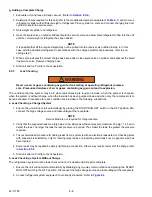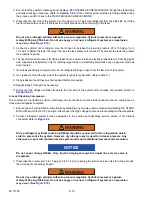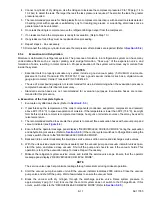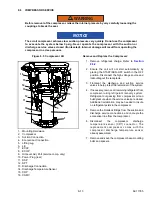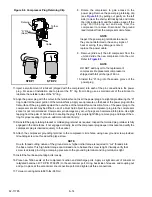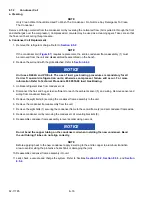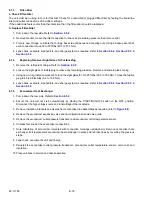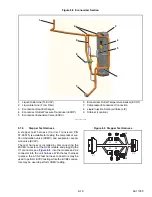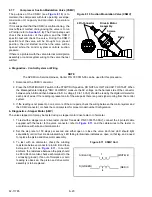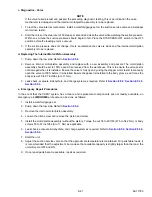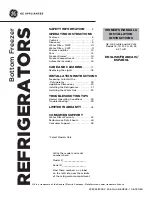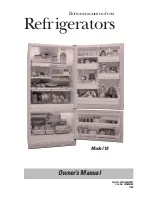
8–7
62-11785
7. Frontseat (close by turning clockwise) the discharge service valve and the refrigerant will be trapped between
the compressor discharge service valve and the liquid line service valve.
8. Before opening up any part of the low side of the system, a slight positive pressure should be indicated on the
pressure gauge. If the pressure is below 0 psig/bar slowly open the liquid line service valve slightly and then
frontseat the valve again. Repeat as necessary in order to raise the pressure above zero.
9. Connect a refrigerant recovery device and a clean refrigerant recovery cylinder to the suction and discharge
service valves and remove any remaining refrigerant from the low side. DO NOT bring the low side pressure
below 0 psig/bar.
10. After making necessary repairs, leak check and evacuate the low side of the refrigeration system. (Refer to
e. Pumping Down The Compressor
The compressor or any of the components attached to it (high pressure switch, oil, etc.) may be serviced or
replaced by pumping the compressor down, and isolating the compressor from the rest of the system.
1. Install a manifold gauge set to allow reading of suction and discharge pressure. See
.
2.
If the compressor is operational
, start the unit and slowly frontseat the suction service valve. shutdown the unit
when the suction pressure drops to 2 psig (0.2 bar). Ensure the unit will not start automatically by disabling any
two way communication and placing the START/RUN-OFF switch in the OFF position. Disconnect the high
voltage source and lockout/tagout the receptacle. Frontseat the discharge service valve to isolate compressor.
There should be very little refrigerant remaining in the compressor at this point.
3.
If the compressor is not operational
, ensure the unit will not start automatically by disabling any two way
communication and placing the START/RUN-OFF switch in the OFF position. Disconnect the high voltage
source and lockout/tagout the receptacle. Frontseat both the discharge and suction service valve to isolate the
compressor.
4. Connect a refrigerant recovery device and a clean refrigerant recovery cylinder to the suction and discharge
service valves and remove any remaining refrigerant from the compressor. DO NOT bring the compressor
pressure below 0 psig/bar.
5. After making necessary repairs, leak check and evacuate the compressor. (Refer to
and
f. Adjusting The Charge Level
Adjustment of the charge level may be required when there has been a leak or the system was not correctly
charged during a previous service.
1. Check charge level by performing the procedures of the preceding step a.
2.
If charge removal is required:
connect a clean evacuated refrigerant recovery cylinder to the liquid line
service valve. Open liquid valve on cylinder. Midseat liquid line service valve and monitor the liquid refrigerant
flow into the cylinder. If the unit is operating, close the cylinder valve and backseat the liquid line service valve
when the ball in the upper sight glass drops to the bottom of the glass. It the unit is not operating, when
approximately 5 lbs. (2.3 kg) have been removed close the cylinder valve and backseat the liquid line service
valve. Proceed to step 7.
3.
If charge is to be added:
place cylinder of refrigerant on a scale and connect a charging line and gauge from
cylinder to liquid line service valve. Start unit in Continuous Operation with a setpoint lower than refrigerated
compartment temperature. Wait until unit switches to high speed operation. Run approximately ten minutes.
4. Note weight of cylinder and refrigerant.
5. Frontseat the liquid line service valve (turn clockwise) and watch the pressure on the manifold gauge. When the
pressure falls below the pressure in the refrigerant cylinder [or to 50 psig (3.4 bar)], open the cylinder valve and
monitor the liquid refrigerant to flow into the unit.
6. When approximately 5 lbs. (2.3 kg) have been added, close the cylinder valve, and backseat the liquid line
service valve.
7. Recheck for the correct refrigerant charge. (Refer to preceding step a.) Repeat preceding steps as required.
When charge level adjustment is complete, remove refrigerant service equipment.
Summary of Contents for VECTOR 8100
Page 2: ......
Page 4: ......
Page 12: ...62 11785 viii ...
Page 16: ...62 11640 12 ...
Page 18: ...62 11785 ...
Page 24: ...62 11785 1 6 1 3 SAFETY DECALS ...
Page 25: ...1 7 62 11785 ...
Page 26: ...62 11785 1 8 ...
Page 27: ...1 9 62 11785 ...
Page 28: ...62 11785 1 10 ...
Page 30: ...62 11785 ...
Page 50: ...62 11785 ...
Page 82: ...62 11785 ...
Page 96: ...62 11785 4 14 ...
Page 98: ...62 11785 ...
Page 129: ...5 31 62 11785 ...
Page 130: ...62 11785 5 32 ...
Page 134: ...62 11785 6 4 ...
Page 138: ...62 11785 ...
Page 230: ...62 11785 ...
Page 271: ...8 41 62 11785 ...
Page 272: ...62 11785 8 42 ...
Page 274: ...62 11785 ...
Page 286: ......
Page 287: ......
Page 288: ...62 11785 10 8 ...
Page 292: ......
Page 293: ......

